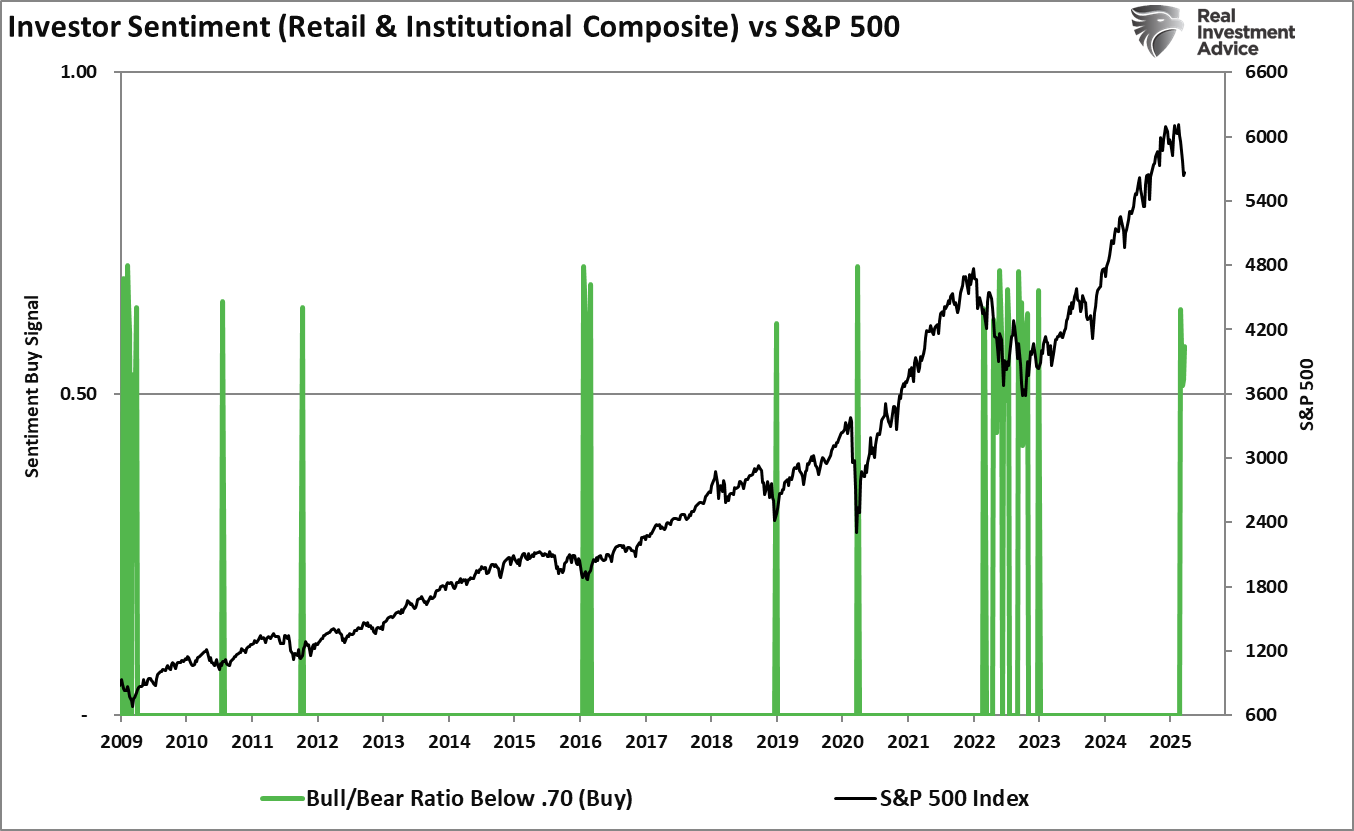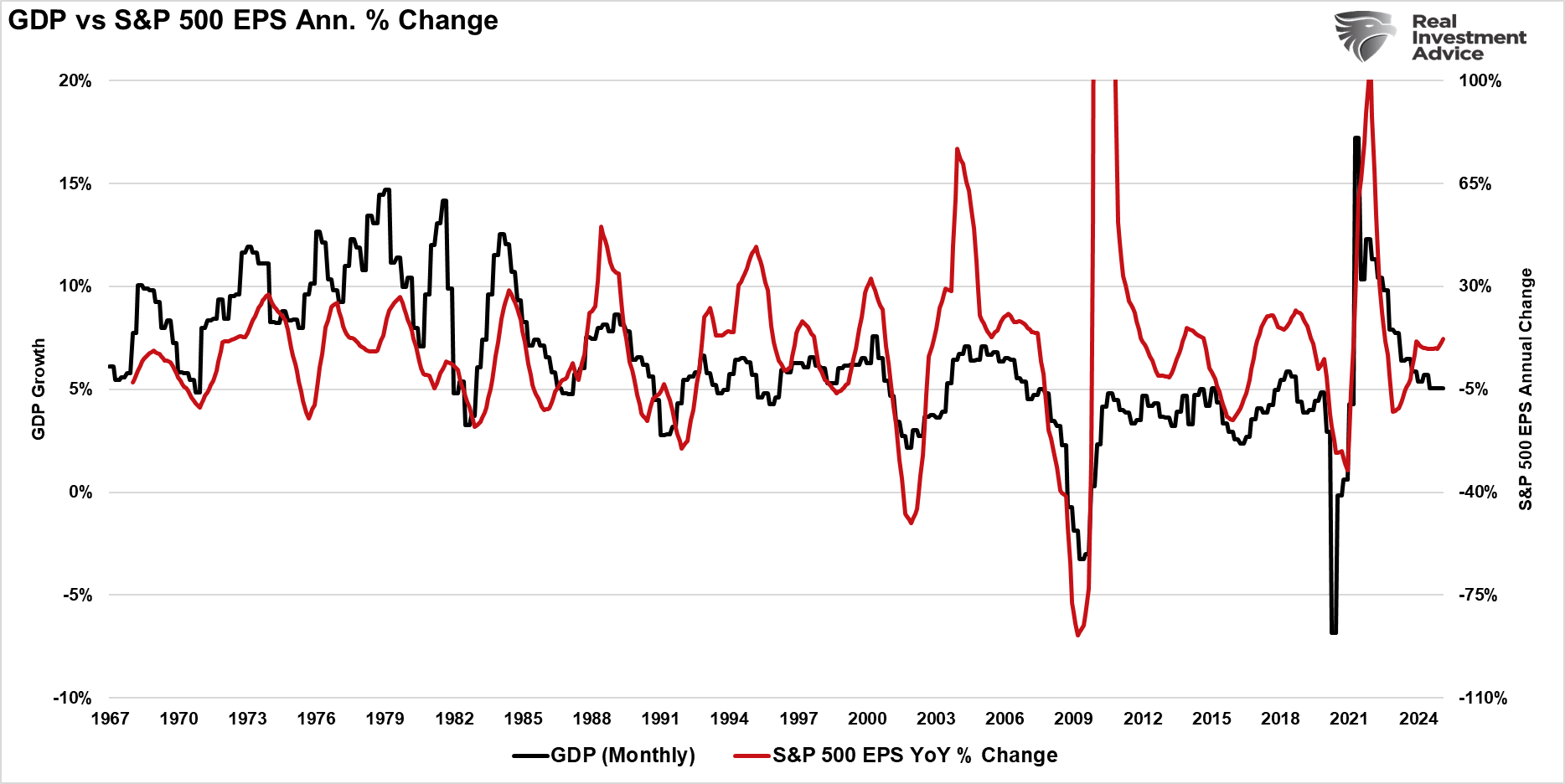Last week, we noted that the market performance, while distressing as of late, has been well within regular correctionary market cycles from a historical perspective. To wit:
“While Trump’s tariffs and bearish headlines currently dominate investors’ psychology, we must remember that corrections are a normal market function. Yes, the market is down roughly 9% from the peak, but we have seen these corrections repeatedly in the past. That does NOT mean a more extensive corrective process is not potentially in process. It only implies that markets are likely in a position for a technical rally to reverse the more extreme oversold conditions. As shown, the MACD and relative strength are currently at levels not seen since the October 2022 lows. Furthermore, the market has completed a 23.6% retracement of the rally from those lows, providing the support needed for a rally.”
The market tried to muster a rally this week, and we are beginning to see early signs of a bottom forming. However, on Friday, the impact of tariffs and a slightly hotter-than-expected print sent markets tumbling. The good news is that the market remains on a buy signal, with an improvement in both money flows and relative strength.
However, those improvements may be fleeting. The market failed its first resistance test at the 200-DMA and decisively broke below the recent uptrend. The current market dynamics are tenuous at best.

While it would not be uncommon for the market to retest recent lows, we are becoming more concerned about a more protracted consolidative or corrective process. The following chart lays out the most probable retracement levels if such occurs. Using the October 2022 lows as the starting point for the bull market rally, the market recently completed a 23.6% retracement of that rally. A continuation of the correction will find support at the following levels:
- The recent lows are around 5500.
- Immediately blow that is the 38.2% retracement level at 5383
- Lastly, the 50% retracement level at 5146 should hold, barring the onset of a fiscal event or recession.
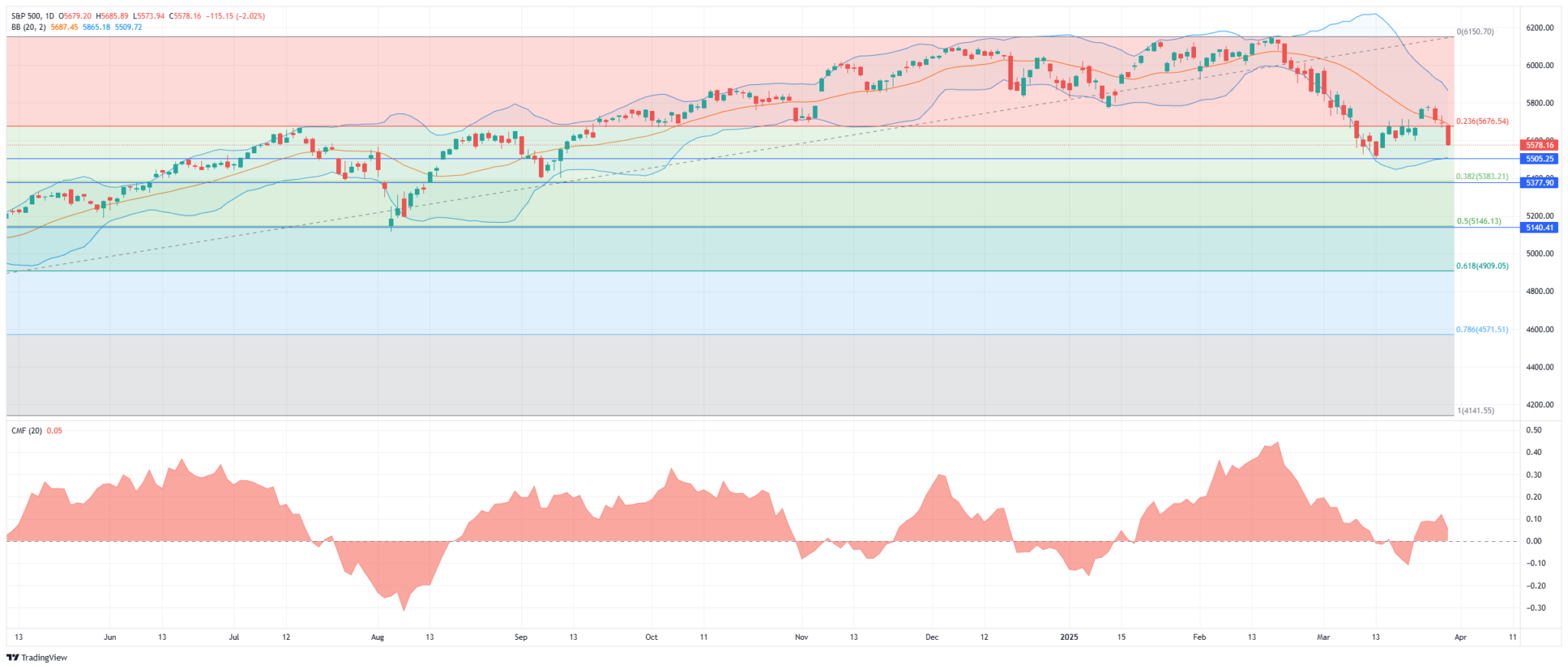
Even if those lower levels are possible and if this is the beginning of a larger corrective process, much like in 2022, the market will have intermittent rallies along the way. As noted last week, nothing in the market is guaranteed. Therefore, we must continue managing risk accordingly until the market’s direction is revealed. When that will be, we are uncertain, so we continue to watch the technicals, make small moves within portfolios, and reduce volatility risk as needed.
Regardless of where the current corrective or consolidation process ends, sellable rallies will exist so that investors can take action. This is the topic of this week’s newsletter.
Sellable Rally
As noted above, the market rallied but failed at the 200-DMA as Trump’s “tariff on, tariff off” narrative continued to roil markets. As we noted in our Daily Market Commentary this past week:
“That catalyst turned out to be President Trump’s “on again, off again” tariff announcements, which created turmoil in earnings expectations. The flux in tariff policies makes it difficult for markets to predict future earnings and corporate profitability. With the “E” in forward valuation measures in flux, markets struggle to price in expected outcomes.”
The question asked most this past week is whether this is a “sellable rally” before the market reverts to a correction or a “buy the dip” moment.
The honest answer is, “We don’t know.”
However, as we discussed on Tuesday in “Correction Over?” there is early evidence that the recent correction may be over, at least for now. The most significant indicators we watch closely are investor sentiment and money flows. Sentiment tells us what investors are “feeling.” As is always the case, investors tend to provide the best contrarian investment signals at extremes of emotions. As we noted in that post:
“Emotions drive investment mistakes, one key reason for monitoring investor sentiment. The chart below is a version of our investor sentiment composite index (retail and professional). The green bars represent periods where combined investor sentiment is extremely bearish. Unsurprisingly, when investors are the most bearish, markets have generally been at or close to their correction lows.”
Notably, sentiment is NOT a market-timing indicator. It tends to indicate when sellers are likely to become exhausted. As we discussed previously, “sellers live higher, buyers live lower.”
“The stock market is always a function of buyers and sellers, each negotiating to make a transaction. While there is a buyer for every seller, the question is always at “what price?”
In the current bull market, few people are willing to sell, so buyers must keep bidding up prices to attract a seller to make a transaction. As long as this remains the case and exuberance exceeds logic, buyers will continue to pay higher prices to get into the positions they want to own. Such is the very definition of the “greater fool” theory.
However, at some point, for whatever reason, this dynamic will change. Buyers will become more scarce as they refuse to pay a higher price. When sellers realize the change, they will rush to sell to a diminishing pool of buyers. Eventually, sellers will begin to “panic sell” as buyers evaporate and prices plunge.”
If the correction is over, we need to see evidence of buyers beginning to emerge. For that evidence, we can turn to our second indicator: money flows. Money flows tell us what investors are “doing” rather than how they feel. Despite the profoundly negative sentiment, money flows increased over the last week, suggesting that “buyers” were beginning to outpace “sellers.”
Also, the volume of transactions is becoming lighter as price declines, suggesting we are not seeing a lot of “panic selling” in the markets currently.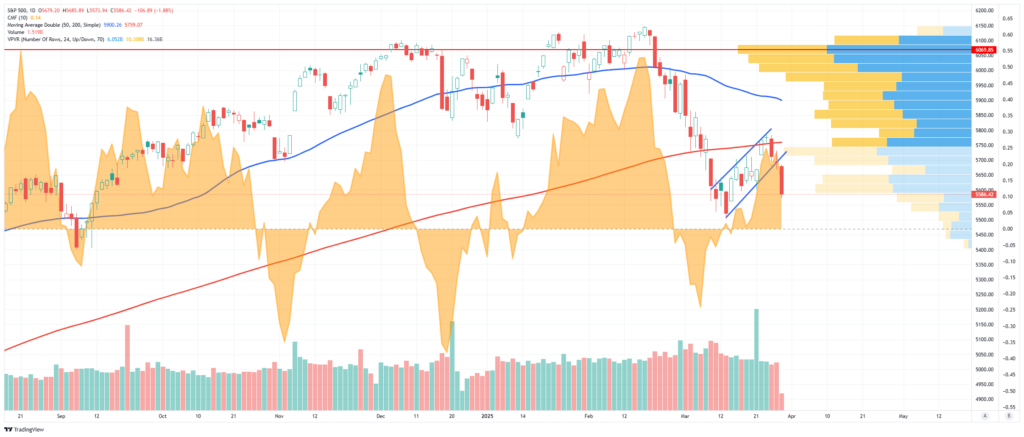
With those two primary indicators turning more positive, we are encouraged that the recent correction may be closer to a bottom than not, providing investors with a “sellable rally” to rebalance portfolio risk.
Why Should I Use A Sellable Rally To Rebalance
As stated above, the most significant issue confronting investors is the continuation of “on again, off again” tariff policies. As shown, those policies are creating a sharp increase in policy uncertainty. We suspect this isn’t going to change going forward, so we suggest that rallies are likely a decent opportunity to reassess portfolio risk. Notably, these spikes in policy uncertainty tend to be near market lows.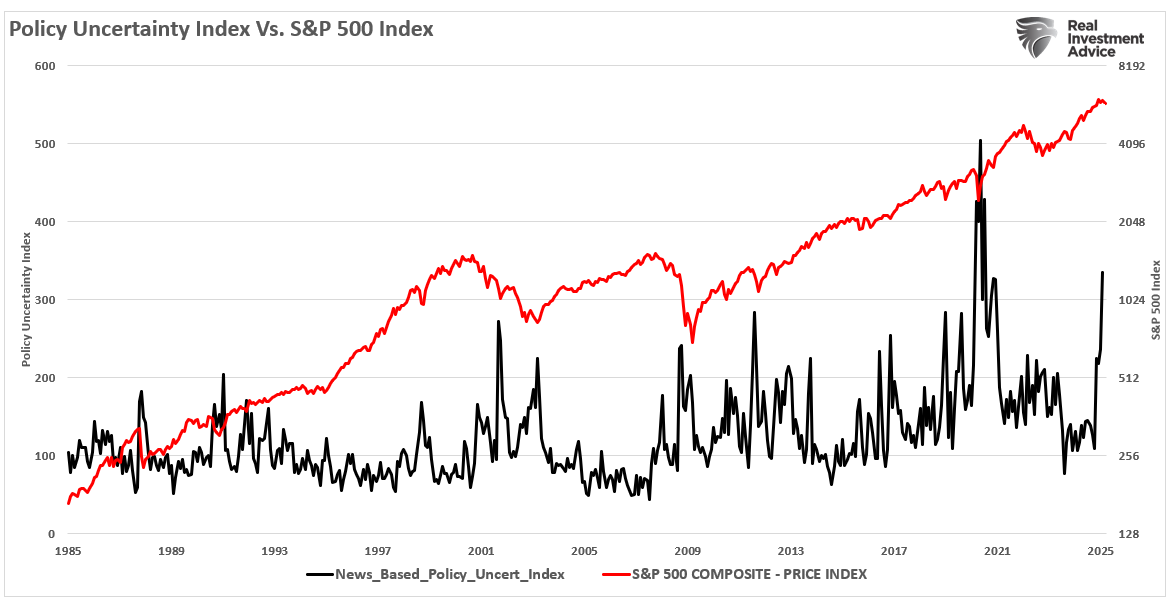
However, concerning policy uncertainty, we can look back at Trump’s first term to see the outcomes of tariff policies and their immediate and longer-term impacts on both volatility and the market.
During Trump’s first term, in which he was embroiled in a trade war with China, we saw spikes in volatility as tariffs were announced. Interestingly, volatility also seems to be responding similarly this time.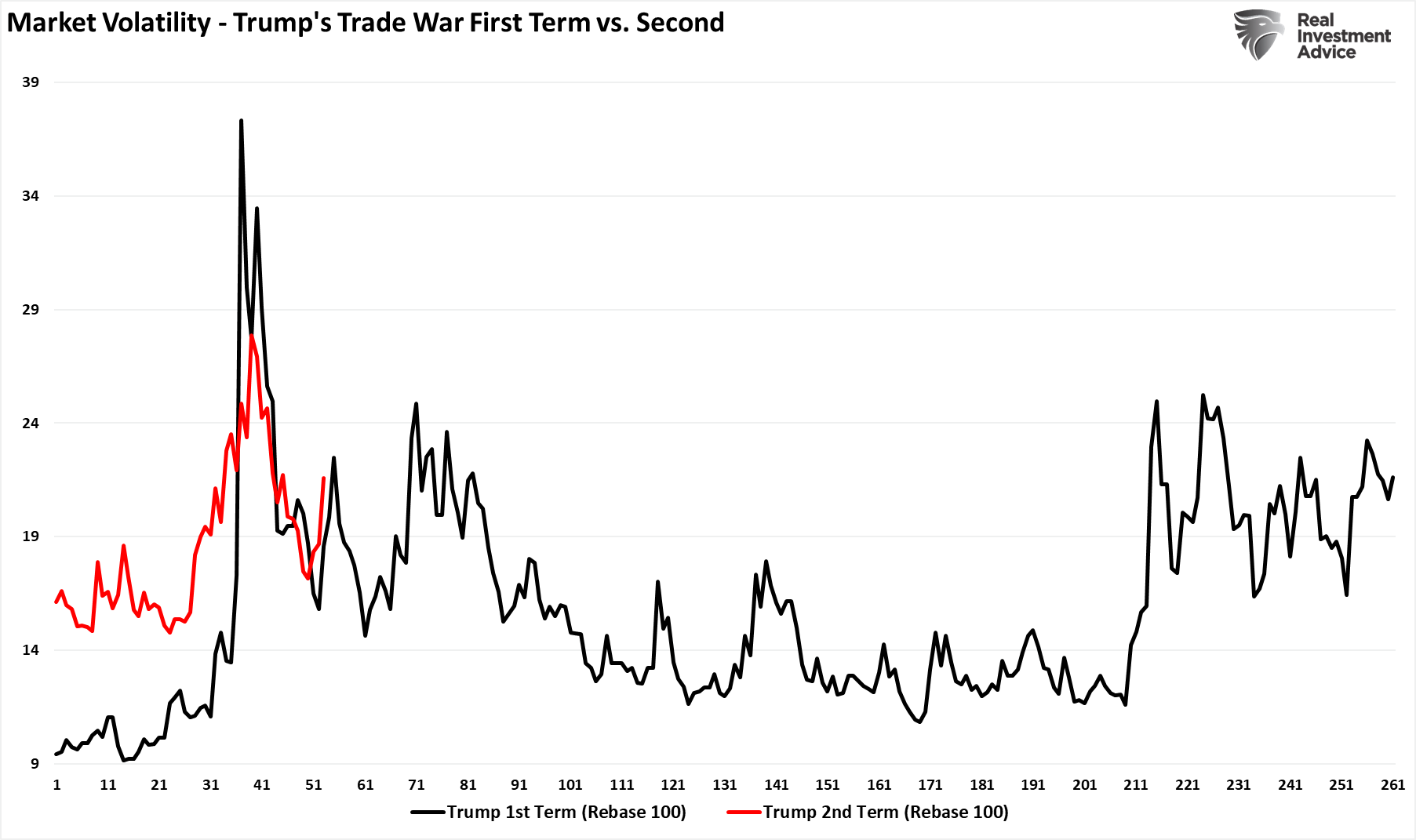
The response to the ever-changing shift in economic policy produces the same results on the market.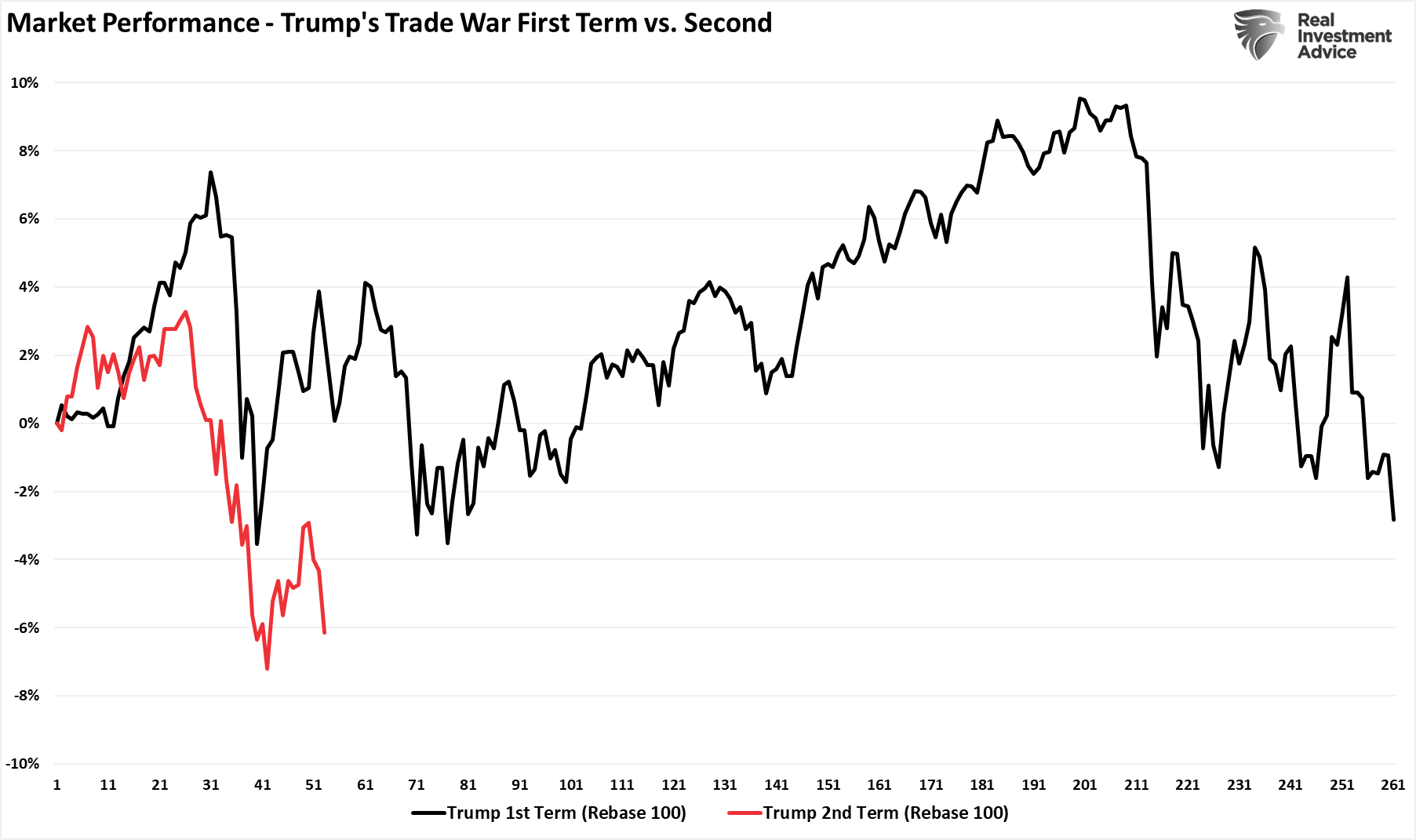
In “Tariffs Not As Bearish As Predicted,” we thoroughly reviewed Trump’s trade war with China to try and assess the short- and long-term impacts of tariffs on the market. We found that while tariffs did not lead to more dire market and economic outcomes, they produced a lot of market volatility, which weighed on investors’ emotions and investing outcomes. To wit:
“Despite the barrage of negative headlines, concerns about inflationary impacts, and economic outcomes, the market ultimately weathered the trade war. As is often the case with more dire predictions, the worse potential outcomes failed to appear. There is no denying that the “trade war” did induce a significant amount of volatility, which made it difficult for investors to “stay the course.” However, in hindsight, we can now see that those spikes in volatility provided repeated buying opportunities for investors to pick up stocks at lower prices.”
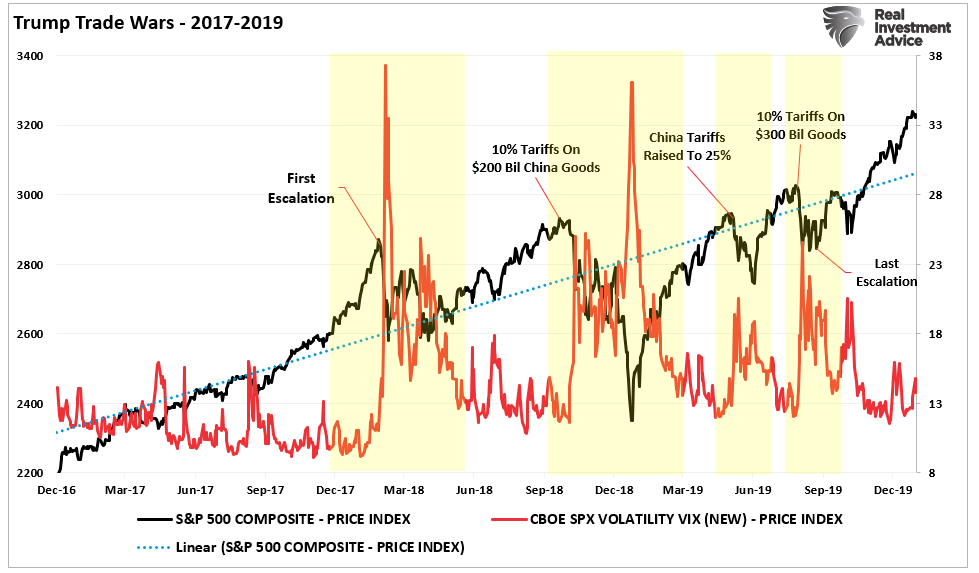
A pick-up in expected volatility as investors try to assess the outcome of earnings can create a challenging environment. As such, we suggest sticking to your investment discipline and not overreacting to short-term market movements. Therefore, use sellable rallies to adjust exposures to raise cash levels slightly, reduce portfolio volatility, and evaluate overall allocation levels relative to the market.
Bull Market Likely On Hold For Now
Wall Street analysts remain optimistic about the market this year despite the recent turmoil. As shown, the range of year-end targets for the remains all over the place but mostly higher than current levels.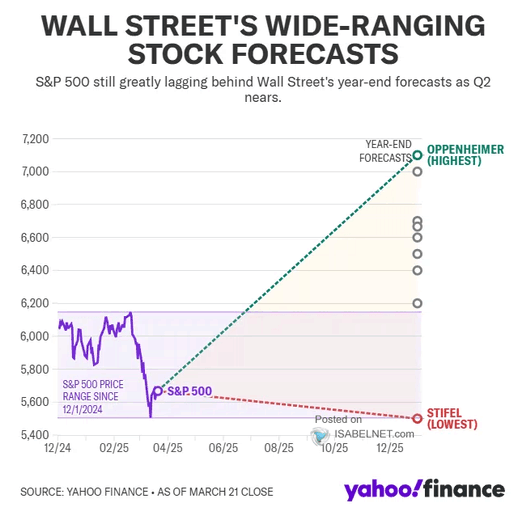
Unfortunately, we remain much more cautious about our views, with this year’s highs remaining our year-end target. The reasons for our more careful view stay the same. Those reasons are rather simplistic:
- The economic data continues to suggest slower growth,
- The impact of the tariff narrative on the markets,
- Clear evidence that the consumer is beginning to be “burdened by what has been,”
- The latest consumer confidence readings were not encouraging, with expectations for future incomes and employment dropping sharply.
That decline in confidence is critical to economic growth, given the massive weight of personal consumption expenditures (PCE) in the calculation. Given the drop in confidence, we should expect to see PCE begin to slow later into this year, with GDP reflecting the same.
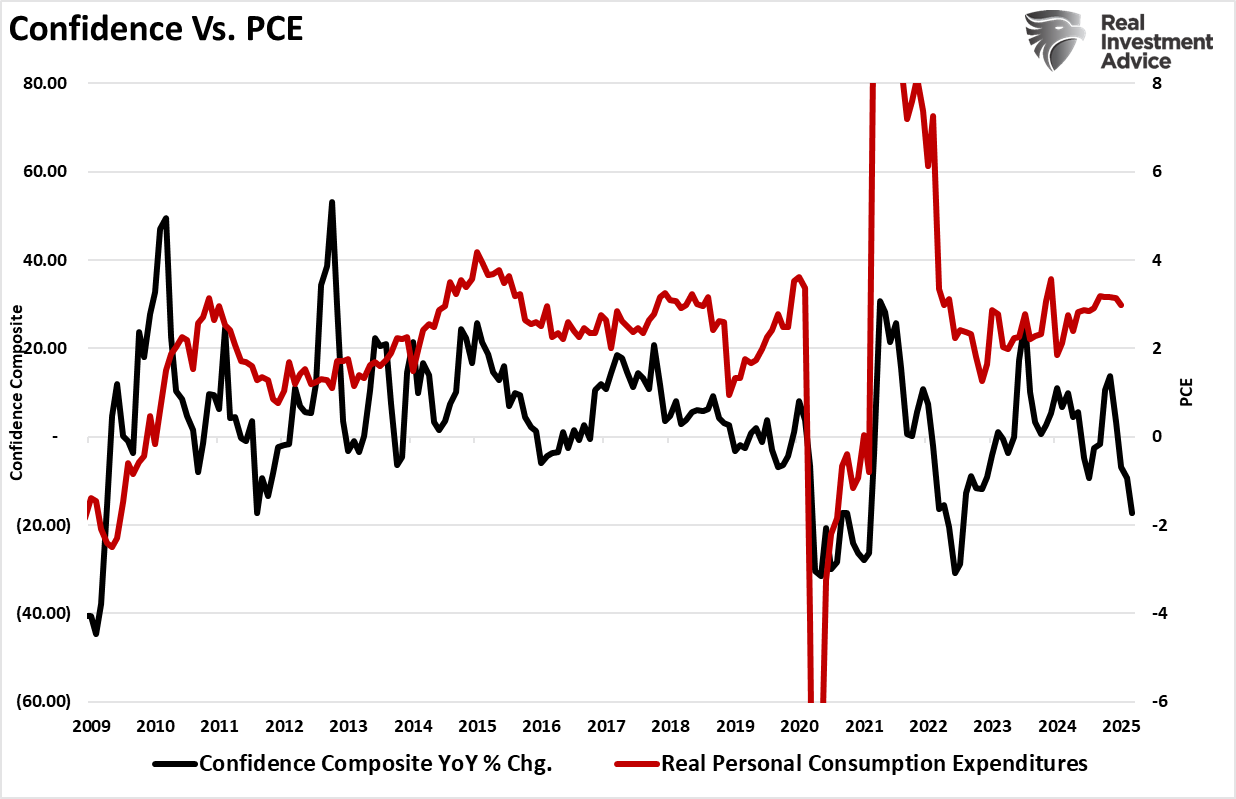
Furthermore, the recent stock market decline was also reflected in the latest consumer sentiment reading. Heading into the end of 2024, we noted that consumer confidence in higher stock prices over the next 12 months had reached a record. This also explained why market valuations were holding at elevated levels. Unsurprisingly, the recent market decline has shattered that confidence.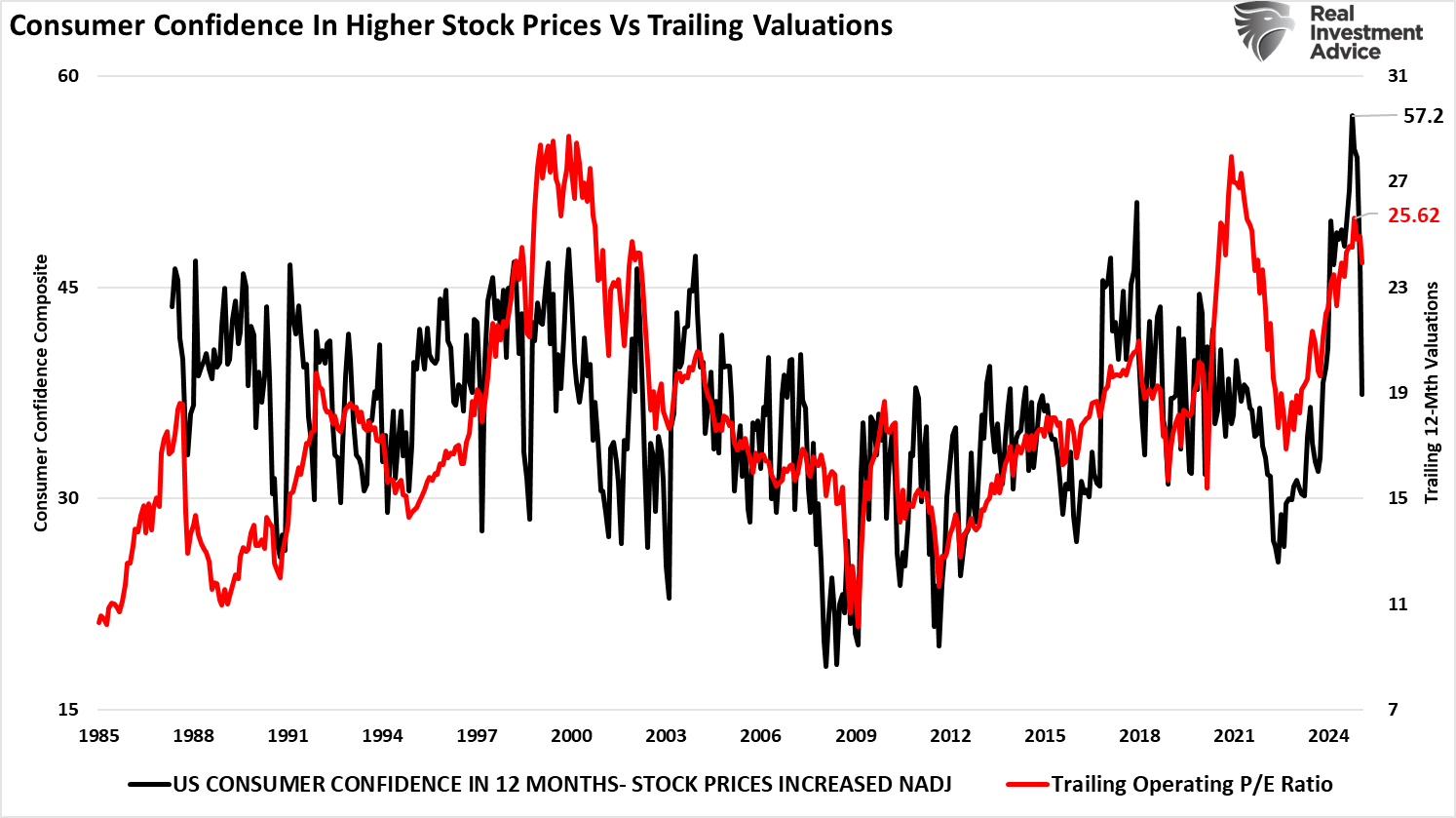
The loss of consumer confidence has implications for the economy and, ultimately, the stock market, given that earnings are derived from economic activity.
The Direction Of Earnings Drive Markets
Our thesis from early this year remains that we will likely see a market this year of repeated bouts of volatility and lower returns. To wit:
“Investing in 2025 will require a blend of optimism and caution. With slowing economic growth, fiscal policy uncertainties, global challenges, overconfident sentiment, and ambitious earnings expectations, investors have plenty of reasons to approach the markets carefully.”
With the economy slowing, earnings growth rates are unlikely to maintain current levels. We have already seen a rather sharp reduction in estimates for Q1, particularly over the last month. We suspect that those downward estimates revisions will accelerate somewhat heading into the Q2 reporting season.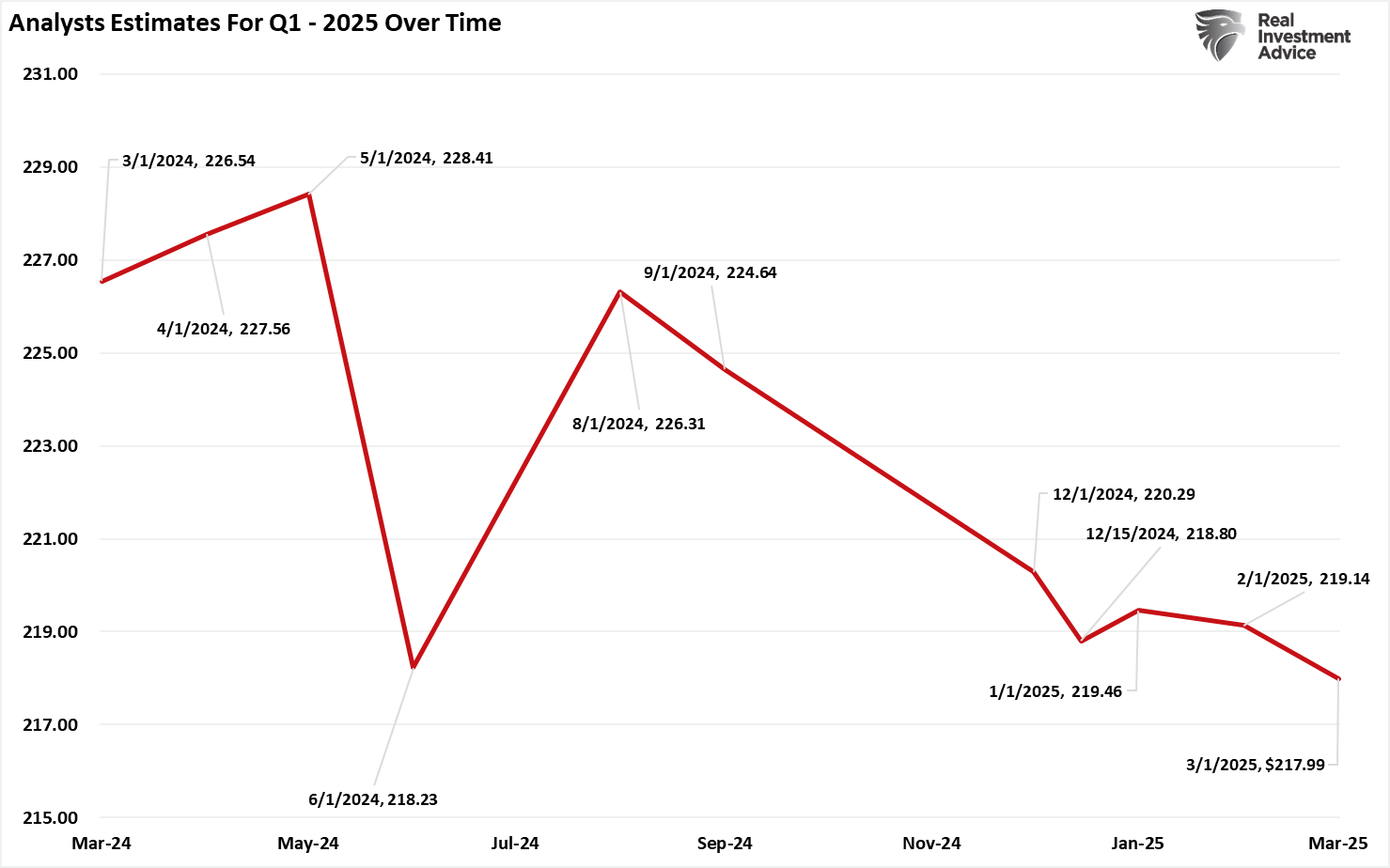
The downward revision in 2026 estimates since their initial release in February is even more notable. (There is more room for negative revisions throughout this year.)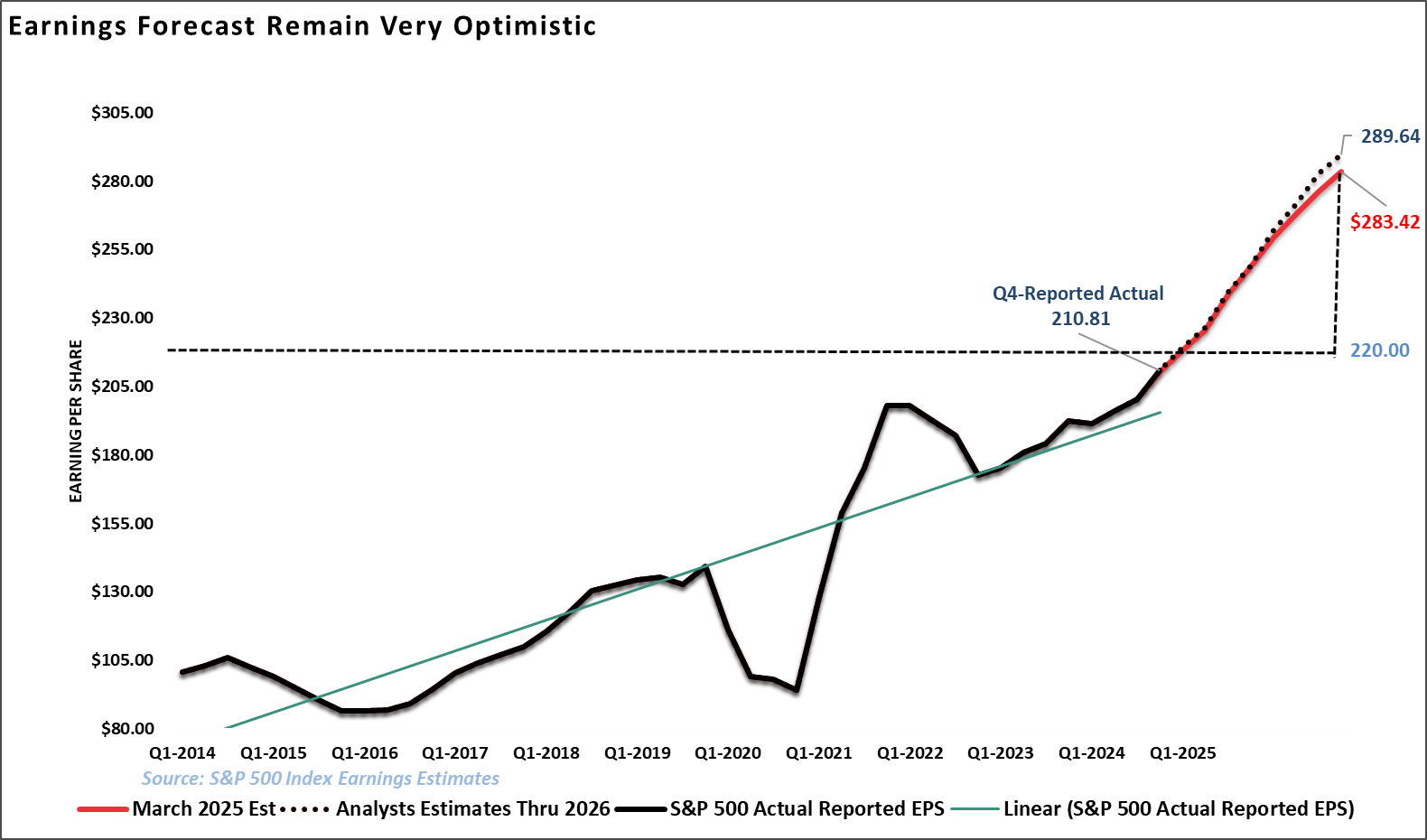
What Does All This Mean?
We suspect the bull market is on hold for all these reasons, and sellable rallies will be more frequent. The current market decline, while not unexpected, is part of that process and likely will not be the last we see this year.
While nothing suggests a recession is imminent, nothing suggests the “bulls” are currently in control.
The rest of this year will likely remain challenging and emotionally exhausting. Try to limit emotionally driven mistakes as much as possible.
How We Are Trading It
We suggest returning to the basics of portfolio and risk management.
I am always reticent to discuss taking a more “risk-averse” approach to the markets. Investors typically interpret such commentary as “sell everything and go to cash.” While recent market events have certainly been challenging, the solution is not to abandon the market altogether. Instead, investors can take practical steps to navigate these uncertainties.
None of this means the next “bear market” is lurking. The data does suggest that being overly aggressive, taking excess risk, and increasing leverage may not have the desired outcome. As such, we continue focusing on our positioning and managing risk accordingly to navigate a more drastic volatility increase than many expected. The rules remain simple for “sellable rallies:”
- Tighten up stop-loss levels to current support levels for each position. (Provides identifiable exit points when the market reverses.)
- Hedge portfolios against significant market declines. (Non-correlated assets, short-market positions, index put options)
- Take profits in positions that have been big winners. (Rebalancing overbought or extended positions to capture gains but continuing to participate in the advance).
- Sell laggards and losers. (If something isn’t working in a market melt-up, it most likely won’t work during a broad decline. It is better to eliminate the risk early.)
- Raise cash and rebalance portfolios to target weightings. (Rebalancing risk regularly keeps hidden risks somewhat mitigated.)
For now, we suggest remaining cautious but not bearish. There will be a time for being more negative in our outlooks, but the data doesn’t support that view yet.
Have a great week.


